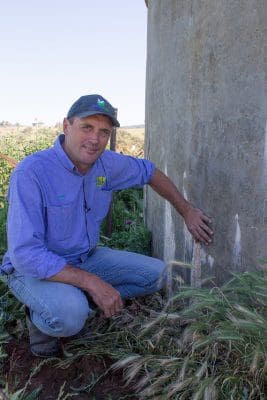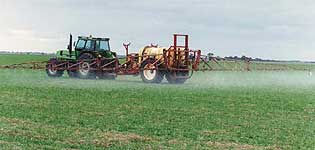WATER quality is often overlooked as a possible contributor to herbicide failure and can lead to confusion over the herbicide resistance status of weeds on a property.

Spray application specialist, Craig Day, says water should be considered as one of the chemicals in any mix, given that water quality varies markedly depending on its source.
Spray application specialist, Craig Day of Spray Safe and Save at Cowra, NSW, said water should be considered as one of the chemicals in any mix, given that water quality varies markedly depending on its source.
“It would be great if all herbicide sprays were applied using rainwater but that is often not practical,” he said.
“The pH, hardness, electrical conductivity and dissolved solids in water all interact with the herbicides and adjuvant products in a mix. It is essential that these parameters are all addressed before any crop protection products are added to the water.”
Mr Day said a water test was a cheap way to ensure the herbicide applied would be as effective as possible in a weed control program.
“Generally, water is considered hard when the calcium carbonate levels exceed 300–400 parts per million (ppm),” he said.
“If glyphosate is added to hard water, the calcium and glyphosate ions react, effectively reducing the uptake of the glyphosate into the plant. By adding ammonium sulfate to the water, the positively charged calcium ions bind with the negatively charged sulfate ions. When glyphosate is added to properly agitated and dissolved ammonium sulfate solution the glyphosate does not bind to calcium ions.”
It is critical that no undissolved ammonium sulfate, via a handling system or within the spray tank, comes into contact with 2,4-D amine formulations. The resulting precipitate is irreversible.
“Hard water will affect formulations of 2,4-DB, glyphosate, 2,4-D amine, Lontrel Advance and Tigrex. If hard water is used with these formulations, there is a greater potential for a reduction in the effectiveness of the chemical,” he said.
High pH affects efficacy
Water with a pH over 8 supports alkaline hydrolysis, which can affect the efficacy of many herbicide and insecticide products, and is often associated with hard water.
Like the example of 2,4-D in hard water, chemicals tend to separate out over time in a high pH environment and the mix become less effective over time.
“The trend toward larger spray tanks means that product is in the tank longer and will be adversely affected when there is a high pH,” Mr Day said.
“At a pH of 8, which is common for tap water in many areas, many products will only remain fully potent for a matter of 1.5 or 2 hours at the most. The use of an acidifying surfactant helps lower the pH to an optimal 4.5 or 6.
“Aside from herbicides, organophosphates and carbamates are particularly susceptible to alkaline hydrolysis so pH needs careful consideration when spraying aphids with a carbamate formulation.”
Test for water quality
When obtaining a water quality test, Mr Day suggests growers ask specifically for the presence of bicarbonates in water to be included in the report.
“A bicarbonate level of 75 ppm and above will lead to reductions in the efficacy of 2,4-D amine and Group A formulations,” he said.
“Ammonium sulfate can be used to reduce the effect of bicarbonates on Group A herbicides, but will produce little improvement on 2,4-D amine formulations.”
 Both total dissolved salts and saline water cause stability issues that can result in separation and blocking of filters, especially if there is insufficient agitation during the mixing process. Also, high salt levels in water will resist manipulations of pH.
Both total dissolved salts and saline water cause stability issues that can result in separation and blocking of filters, especially if there is insufficient agitation during the mixing process. Also, high salt levels in water will resist manipulations of pH.
Mr Day said growers should get their water source tested regularly.
“If you take two samples and retain the second jar of water you can use it to calibrate your eye using a pool and spa testing kit and the test results. This can become an ongoing monitoring tool,” he said.
Caution with batching tanks
Another problem Mr Day commonly sees is the incorrect use of batching tanks, where products are concentrated in small tanks without sufficient water.
He said growers should avoid having the entire tank load amount of acidifying adjuvant in direct contact with other chemistry and that 2,4-D amine was never allowed to sit on undissolved ammonium sulfate.
“Similarly, high concentrations of glyphosate and 2,4-D amine in a batching tank can cause the glyphosate to lose its effectiveness,” he said.
“It is very important that water is conditioned first, and that sufficient water and ample agitation is used when preparing a spray load. Time is always against growers but there is no point hurrying just to apply a load that won’t work because the chemistry is wrong in the tank.”
New product interactions
As new products come to market, Mr Day suggests growers ask their advisors where the product fits in the mixing order and to highlight any interactions with water quality parameters.
“Ask your advisor to provide the correct mixing order when writing the advice sheet,” he said.
“You will then have this advice to follow and can record the mixing order on file. This information, and a water quality test, will help unravel any issues with a spray’s efficacy and, in combination with a herbicide resistance test, assist with developing a robust herbicide program.”
Source: Weedsmart
The careful management of spray events is highlighted in the WeedSmart 10 Point Plan for managing herbicide resistance.
Visit the WeedSmart website: www.weedsmart.org.au

HAVE YOUR SAY